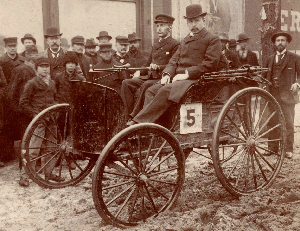
This Week in Motorhead History: History’s Slowest Winner
This Week In Motorhead History
The year is 1895. America is still skeptical of the gas-powered automobile. Henry Ford’s assembly line would not begin rolling for eighteen years. The age of speed, turn signals or even roads is far in the distant future.
A future that would never have come to pass, were it not for Charles and Frank Duryea and the Duryea Motor Wagon Company, the very first American car company to build gasoline automobiles, paving the way for Ransom Olds, William C. Durant and, of course, Henry Ford.
Much of the Duryea brothers; early success can be attributed to a Thanksgiving morning in that first year 1895 when they proudly wore the title of another first – the first United States auto race where any of the entrants finished.
And finish they did.
 Frank Duryea won the Chicago Times-Herald Race in Chicago in the second Duryea Motor Wagon produced, finished in 1894. He completed the 54-mile course at a blistering speed of 7.5 miles per hour. Eighty-three cars had been initially entered into the competition after the Chicago Times-Herald first announced it in July of that year, but only six were completed and capable of arriving to the starting line by Thanksgiving.
Frank Duryea won the Chicago Times-Herald Race in Chicago in the second Duryea Motor Wagon produced, finished in 1894. He completed the 54-mile course at a blistering speed of 7.5 miles per hour. Eighty-three cars had been initially entered into the competition after the Chicago Times-Herald first announced it in July of that year, but only six were completed and capable of arriving to the starting line by Thanksgiving.
In fact, so few cars appeared at the originally scheduled date of November 2, 1895, that they were forced to push the event back. Recall, if you will, that the very first “cars” had barely been produced two years earlier, and that the sum total of the car industry at the time was madmen tinkering in their garages like over-excited fathers before a pinewood derby race.
In fact, the very intent behind the race was to stoke up excitement about the fledgling auto industry, as well as to boost sales. The idea of a car was so new – and so foreign – that the newspaper editors at the Times-Herald literally did not know what to call them. And neither did the police, who pulled over favored winner Elwood Haynes and one of three Benz drivers before they arrived at the race – on horseback, of course. This pushed the beginning of the first successful American auto race back even further, as organizers explained this newfangled technology to the coppers.
But despite the mishaps and confusion, it was clear that race organizers at the Times-Herald understood the value of this odd new industry, with prizes for the winners totaling $5,000, over $140,000 by today’s standard.
 And while the Duryea Motor Wagon would not go onto the fame of any of the Benz vehicles that it competed against, it most certainly benefited from the exposure and success of that very first race. They sold thirteen cars by the end of 1896, the first ten standing out as, yet another, first – the first production vehicles ever sold in America.
And while the Duryea Motor Wagon would not go onto the fame of any of the Benz vehicles that it competed against, it most certainly benefited from the exposure and success of that very first race. They sold thirteen cars by the end of 1896, the first ten standing out as, yet another, first – the first production vehicles ever sold in America.
Despite their success and luck, the Duryea Motor Company suffered in-fighting, challenges, and setbacks as the auto industry slowly found its foothold. Competing against the vast new field of challengers, most of whom would not ever make it to the point of production, the Duryea brothers separated and worked together from a distance, with variations of their prized company limping along for several years. Charles would go on to produce cars, mostly without success, until 1917 and Frank would share his expertise with the industry until 1927.
And yet, despite their ups and downs, despite their inability to recreate Henry Ford’s success with the “Everyman’s Car” or their inability to recreate their earlier luck, the Duryea brothers undoubtedly shaped the future of American cars. They are not particularly well-known, for after 1895 they were not particularly successful, but they are important, one of the puzzle pieces in what makes up the wild west history of early autos.
Could we have done it without them? Who’s to say? If it had not been the Duryea Motor Wagon that day, it might have been an early Benz or a new-fangled motorcycle the next. Still, it was them, two scrappy boys from New England, who stand as a testament to fortitude, passion, and innovation, pillars upon which the entire auto industry stands.
And hey, if you sat in an open-cockpit beast going 7 miles per hour for over 10 hours and 23 minutes in weather where other challengers literally fainted from exposure, you’d be pretty worthy of a spot in the history books too. There’s no doubt that they earned that win and set into motion a world they could have never expected.![]()

